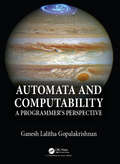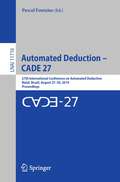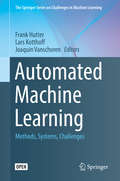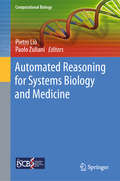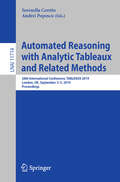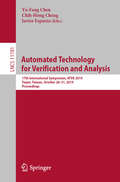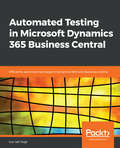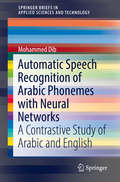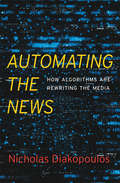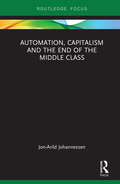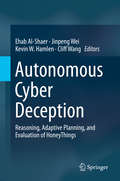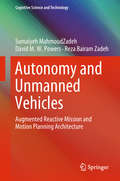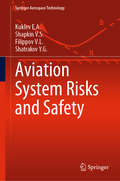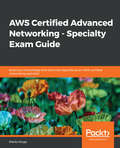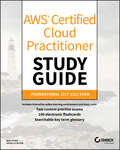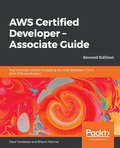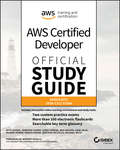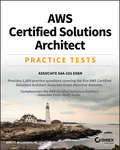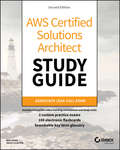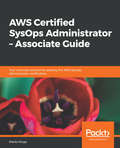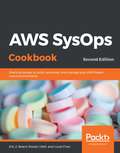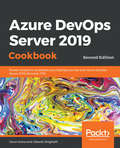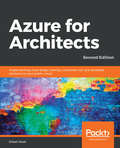- Table View
- List View
Autocomplete: The Book
by Justin HookEvery time a browser autocompletes our search query, it's showing us what millions of other people all over the world are searching for. This curious collection showcases the very best of the often strange yet 100% real autocomplete suggestions offered up by popular search engines, compiling them into one hilarious, fascinating, and mildly disturbing volume. Each page contains one search and its 10 best autocomplete suggestions, including the most and least common, from "Why is Ryan Gosling...eating cereal?" to "If the Earth is round...why are shoes flat?" With easy-to-read spreads and playful black-and-white line art throughout, Autocomplete provides a nearly unfiltered look at what people actually search for when they think no one's watching.
Automata and Computability: A Programmer's Perspective
by Ganesh GopalakrishnanAutomata and Computability is a class-tested textbook which provides a comprehensive and accessible introduction to the theory of automata and computation. The author uses illustrations, engaging examples, and historical remarks to make the material interesting and relevant for students. It incorporates modern/handy ideas, such as derivative-based parsing and a Lambda reducer showing the universality of Lambda calculus. The book also shows how to sculpt automata by making the regular language conversion pipeline available through a simple command interface. A Jupyter notebook will accompany the book to feature code, YouTube videos, and other supplements to assist instructors and studentsFeatures Uses illustrations, engaging examples, and historical remarks to make the material accessible Incorporates modern/handy ideas, such as derivative-based parsing and a Lambda reducer showing the universality of Lambda calculus Shows how to "sculpt" automata by making the regular language conversion pipeline available through simple command interface Uses a mini functional programming (FP) notation consisting of lambdas, maps, filters, and set comprehension (supported in Python) to convey math through PL constructs that are succinct and resemble math Provides all concepts are encoded in a compact Functional Programming code that will tesselate with Latex markup and Jupyter widgets in a document that will accompany the books. Students can run code effortlessly href="https://github.com/ganeshutah/Jove.git/"here.
Automated Deduction – CADE 27: 27th International Conference on Automated Deduction, Natal, Brazil, August 27–30, 2019, Proceedings (Lecture Notes in Computer Science #11716)
by Pascal FontaineThis book constitutes the proceeding of the 27th International Conference on Automated Deduction, CADE 27, held in Natal, Brazil, in August 2019. The 27 full papers and 7 system descriptions presented were carefully reviewed and selected from 65 submissions. CADE is the major forum for the presentation of research in all aspects of automated deduction, including foundations, applications, implementations, and practical experience.
Automated Machine Learning: Methods, Systems, Challenges (The Springer Series on Challenges in Machine Learning)
by Lars Kotthoff Joaquin Vanschoren Frank HutterThis open access book presents the first comprehensive overview of general methods in Automated Machine Learning (AutoML), collects descriptions of existing systems based on these methods, and discusses the first series of international challenges of AutoML systems. The recent success of commercial ML applications and the rapid growth of the field has created a high demand for off-the-shelf ML methods that can be used easily and without expert knowledge. However, many of the recent machine learning successes crucially rely on human experts, who manually select appropriate ML architectures (deep learning architectures or more traditional ML workflows) and their hyperparameters. To overcome this problem, the field of AutoML targets a progressive automation of machine learning, based on principles from optimization and machine learning itself. This book serves as a point of entry into this quickly-developing field for researchers and advanced students alike, as well as providing a reference for practitioners aiming to use AutoML in their work.
Automated Reasoning for Systems Biology and Medicine (Computational Biology #30)
by Pietro Liò Paolo ZulianiThis book presents outstanding contributions in an exciting, new and multidisciplinary research area: the application of formal, automated reasoning techniques to analyse complex models in systems biology and systems medicine. Automated reasoning is a field of computer science devoted to the development of algorithms that yield trustworthy answers, providing a basis of sound logical reasoning. For example, in the semiconductor industry formal verification is instrumental to ensuring that chip designs are free of defects (or “bugs”). Over the past 15 years, systems biology and systems medicine have been introduced in an attempt to understand the enormous complexity of life from a computational point of view. This has generated a wealth of new knowledge in the form of computational models, whose staggering complexity makes manual analysis methods infeasible. Sound, trusted, and automated means of analysing the models are thus required in order to be able to trust their conclusions. Above all, this is crucial to engineering safe biomedical devices and to reducing our reliance on wet-lab experiments and clinical trials, which will in turn produce lower economic and societal costs. Some examples of the questions addressed here include: Can we automatically adjust medications for patients with multiple chronic conditions? Can we verify that an artificial pancreas system delivers insulin in a way that ensures Type 1 diabetic patients never suffer from hyperglycaemia or hypoglycaemia? And lastly, can we predict what kind of mutations a cancer cell is likely to undergo? This book brings together leading researchers from a number of highly interdisciplinary areas, including: · Parameter inference from time series · Model selection · Network structure identification · Machine learning · Systems medicine · Hypothesis generation from experimental data · Systems biology, systems medicine, and digital pathology · Verification of biomedical devices “This book presents a comprehensive spectrum of model-focused analysis techniques for biological systems ...an essential resource for tracking the developments of a fast moving field that promises to revolutionize biology and medicine by the automated analysis of models and data.”Prof Luca Cardelli FRS, University of Oxford
Automated Reasoning with Analytic Tableaux and Related Methods: 28th International Conference, TABLEAUX 2019, London, UK, September 3-5, 2019, Proceedings (Lecture Notes in Computer Science #11714)
by Serenella Cerrito Andrei PopescuThis book constitutes the proceedings of the 28th International Conference on Automated Reasoning with Analytic Tableaux and Related Methods, TABLEAUX 2019, held in London, UK, in September 2019, colocated with the 12th International Symposium on Frontiers on Combining Systems, FroCoS 2019. The 25 full papers presented were carefully reviewed and selected from 43 submissions.They present research on all aspects of the mechanization of tableaux-based reasoning and related methods, including theoretical foundations, implementation techniques, systems development and applications. The papers are organized in the following topical sections: tableau calculi, sequent calculi, semantics and combinatorial proofs, non-wellfounded proof systems, automated theorem provers, and logics for program or system verification.
Automated Technology for Verification and Analysis: 17th International Symposium, ATVA 2019, Taipei, Taiwan, October 28–31, 2019, Proceedings (Lecture Notes in Computer Science #11781)
by Yu-Fang Chen Chih-Hong Cheng Javier EsparzaThis book constitutes the refereed proceedings of the 17th International Symposium on Automated Technology for Verification and Analysis, ATVA 2019, held in Taipei, Taiwan in October 2019.The 24 regular papers presented together with 3 tool papers were carefully reviewed and selected from 65 submissions. The symposium is dedicated to the promotion of research on theoretical and practical aspects of automated analysis, verification and synthesis by providing a forum for interaction between the regional and the international research communities and industry in the field. The papers focus on cyber-physical systems; runtime techniques; testing; automata; synthesis; stochastic systems and model checking.
Automated Testing in Microsoft Dynamics 365 Business Central: Efficiently automate test cases in Dynamics NAV and Business Central
by Luc van VugtLearn how to write automated tests for Dynamics 365 Business Central and see how to implement it in your daily workKey FeaturesLeverage automated testing to advance over traditional manual testing methodsWrite, design, and implement automated testsExplore various testing frameworks and tools compatible with Microsoft Dynamics 365 Business CentralBook DescriptionDynamics 365 Business Central is the new cloud-based SaaS ERP proposition from Microsoft. It’s not as simple as it used to be way back when it was called Navigator, Navision Financials, or Microsoft Business Solutions-Navision. Our development practices are becoming more formal, and with this, the call for test automation is pressing on us.This book will teach you to leverage testing tools available with Dynamics 365 Business Central to perform automated testing. We’ll begin with a quick introduction to automated testing, followed by an overview of test automation in Dynamics 365 Business Central. Then you’ll learn to design and build automated tests and we’ll go through some efficient methods to get from requirements to application and testing code. Lastly, you’ll learn to incorporate your own and Microsoft tests into your daily development practice.By the end of the book, you’ll be able to write your own automated tests for Dynamics 365 Business Central.What you will learnUnderstand what automated tests are, and when and why to use themExplore the five pillars of the Testability Framework of Business CentralDesign and write automated tests for Business CentralMake use of standard automated tests and their helper librariesIntegrate automated tests into your development practiceWho this book is forThis book is for consultants, testers, developers, and development managers working with Microsoft Dynamics NAV and Business Central. Being a book on automated testing techniques, it also caters to both functional and technical development teams.
Automatic Speech Recognition of Arabic Phonemes with Neural Networks: A Contrastive Study of Arabic and English (SpringerBriefs in Applied Sciences and Technology)
by Mohammed DibThis book presents a contrastive linguistics study of Arabic and English for the dual purposes of improved language teaching and speech processing of Arabic via spectral analysis and neural networks. Contrastive linguistics is a field of linguistics which aims to compare the linguistic systems of two or more languages in order to ease the tasks of teaching, learning, and translation. The main focus of the present study is to treat the Arabic minimal syllable automatically to facilitate automatic speech processing in Arabic. It represents important reading for language learners and for linguists with an interest in Arabic and computational approaches.
Automating the News: How Algorithms Are Rewriting the Media
by Nicholas DiakopoulosFrom hidden connections in big data to bots spreading fake news, journalism is increasingly computer-generated. Nicholas Diakopoulos explains the present and future of a world in which algorithms have changed how the news is created, disseminated, and received, and he shows why journalists—and their values—are at little risk of being replaced.
Automation and Utopia: Human Flourishing in a World without Work
by John DanaherAutomating technologies threaten to usher in a workless future, but John Danaher argues that this can be a good thing. A world without work may be a kind of utopia, free of the misery of the job and full of opportunities for creativity and exploration. If we play our cards right, automation could be the path to idealized forms of human flourishing.
Automation, Capitalism and the End of the Middle Class (Routledge Focus on Economics and Finance)
by Jon-Arild JohannessenIn this book, the author argues that a new form of capitalism is emerging at the threshold of the Fourth Industrial Revolution. He asserts that we are in the midst of a transition from democratic capitalism to feudal capitalism and highlights how robotization and innovation is leading to a social crisis for the middle classes as economic inequality is on the rise. Johannessen outlines the three elements – Balkanization, the Great Illusion, and the plutocracy – which are referred to here as feudal structures. He describes, analyzes, and discusses these elements both individually and in interaction with each other, and asks: "What structures and processes are promoting and boosting feudal capitalism?" Additionally, the book serves to generate knowledge about how the middle class will develop in the Fourth Industrial Revolution. It shows the various effects of robotization on the middle class, where middle class jobs are transformed, deconstructed, and re-constructed and new part-time jobs are created for the middle class. Given the interest in the Fourth Industrial Revolution, the book will appeal to students of economic sociology and political economy as well as those in innovation and knowledge management courses focusing upon the emerging innovation economy. The topic will attract policymakers, and the accessible and engaging tone will also make the book of interest to the general public.
Autonomous Cyber Deception: Reasoning, Adaptive Planning, and Evaluation of HoneyThings
by Cliff Wang Ehab Al-Shaer Jinpeng Wei Kevin W. HamlenThis textbook surveys the knowledge base in automated and resilient cyber deception. It features four major parts: cyber deception reasoning frameworks, dynamic decision-making for cyber deception, network-based deception, and malware deception. An important distinguishing characteristic of this book is its inclusion of student exercises at the end of each chapter. Exercises include technical problems, short-answer discussion questions, or hands-on lab exercises, organized at a range of difficulties from easy to advanced,. This is a useful textbook for a wide range of classes and degree levels within the security arena and other related topics. It’s also suitable for researchers and practitioners with a variety of cyber security backgrounds from novice to experienced.
Autonomy and Unmanned Vehicles: Augmented Reactive Mission And Motion Planning Architecture (Cognitive Science And Technology Ser.)
by Somaiyeh MahmoudZadeh Reza Bairam Zadeh David M.W. PowersThis book addresses higher–lower level decision autonomy for autonomous vehicles, and discusses the addition of a novel architecture to cover both levels. The proposed framework’s performance and stability are subsequently investigated by employing different meta-heuristic algorithms. The performance of the proposed architecture is shown to be largely independent of the algorithms employed; the use of diverse algorithms (subjected to the real-time performance of the algorithm) does not negatively affect the system’s real-time performance. By analyzing the simulation results, the book demonstrates that the proposed model provides perfect mission timing and task management, while also guaranteeing secure deployment. Although mainly intended as a research work, the book’s review chapters and the new approaches developed here are also suitable for use in courses for advanced undergraduate or graduate students.
Aviation System Risks and Safety (Springer Aerospace Technology)
by Kuklev E.A. Shapkin V.S. Filippov V.L. Shatrakov Y.G.This book provides a solution to “rare event” problems without using the classical theory of reliability and theory of probability. This solution is based on the methodology of risk assessment as “measure of danger” (in keeping with the ICS RAS) and an expert approach to determining systems’ safety indications using Fuzzy Sets methods. Further, the book puts forward a new concept: “Reliability, Risks, and Safety” (RRS). The book’s main goal is to generalize present results and underscore the need to develop an alternative approach to safety level assessment and risk management for technical (aviation) systems in terms of Fuzzy Sets objects, in addition to traditional probabilistic safety analysis (PSA). The concept it proposes incorporates ICAO recommendations regarding proactive system control and the system’s responses to various internal and external disturbances.
AWS Certified Advanced Networking - Specialty Exam Guide: Build your knowledge and technical expertise as an AWS-certified networking specialist
by Marko SlugaDevelop technical skills and expertise to automate AWS networking tasksKey FeaturesA fast paced guide that will help you pass the exam with confidenceLearn advanced skill sets to build effective AWS networking solutions Enhance your AWS skills with practice exercises and mock testsBook DescriptionAmazon has recently come up a with specialty certifications which validates a particular user's expertise that he/she would want to build a career in. Since the Cloud market now demands of AWS networking skills this becomes the most wanted certification to upheld ones industry portfolio. This book would be your ideal companion to getting skilled with complex and creative networking solutions. Cloud practitioners or associate-level certified individuals interested in validating advanced skills in networking can opt for this practical guide.This book will include topics that will help you design and implement AWS and hybrid IT network architectures along with some network automation tasks. You will also delve deep into topics that will help you design and maintain network architecture for all AWS services. Like most of our certification guides this book will also follow a unique approach of testing your learning with chapter-level practice exercises and certification-based mock tests. The exam mock tests will help you gauge whether you are ready to take the certification exam or not. This book will also be an advanced guide for networking professionals to enhance their networking skills and get certified. By the end of this book, you will be all equipped with AWS networking concepts and techniques and will have mastered core architectural best practices.What you will learnFormulate solution plans and provide guidance on AWS architecture best practicesDesign and deploy scalable, highly available, and fault-tolerant systems on AWSIdentify the tools required to replicate an on-premises network in AWSAnalyze the access and egress of data to and from AWSSelect the appropriate AWS service based on data, compute, database, or security requirementsEstimate AWS costs and identify cost control mechanismsWho this book is forIf you are a system administrator, or a network engineer interested in getting certified with an advanced Cloud networking certification then this book is for you. Prior experience in Cloud administration and networking would be necessary.
AWS Certified Cloud Practitioner Study Guide: CLF-C01 Exam
by David Clinton Ben PiperSet yourself apart by becoming an AWS Certified Cloud Practitioner Take the next step in your career by expanding and validating your skills on the Amazon Web Services (AWS) Cloud. The AWS Certified Cloud Practitioner Study Guide: Exam CLF-C01 provides a solid introduction to this industry-leading technology, relied upon by thousands of businesses across the globe, as well as the resources you need to prove your knowledge in the AWS Certification Exam. This guide offers complete and thorough treatment of all topics included in the exam, beginning with a discussion of what the AWS cloud is and its basic global infrastructure and architectural principles. Other chapters dive into the technical, exploring core characteristics of deploying and operating in the AWS Cloud Platform, as well as basic security and compliance aspects and the shared security model. In addition, the text identifies sources of documentation or technical assistance, such as white papers or support tickets. To complete their coverage, the authors discuss the AWS Cloud value proposition and define billing, account management, and pricing models. This includes describing the key services AWS can provide and their common use cases (e.g., compute, analytics, etc.). Distinguish yourself as an expert by obtaining a highly desirable certification in a widely used platform Hone your skills and gain new insights on AWS whether you work in a technical, managerial, sales, purchasing, or financial field Fully prepare for this new exam using expert content and real-world knowledge, key exam essentials, chapter review questions, and other textual resources Benefit from access to the Sybex online interactive learning environment and test bank, including chapter tests, practice exams, key term glossary, and electronic flashcards The AWS Certified Cloud Practitioner Study Guide is essential reading for any professional in IT or other fields that work directly with AWS, soon-to-be graduates studying in those areas, or anyone hoping to prove themselves as an AWS Certified Cloud Practitioner.
AWS Certified Developer – Associate Guide: Your one-stop solution to passing the AWS developer's 2019 (DVA-C01) certification, 2nd Edition
by Vipul Tankariya Bhavin ParmarLearn from the AWS subject-matter experts, explore real-world scenarios, and pass the AWS Certified Developer – Associate examKey FeaturesThis fast-paced guide will help you clear the AWS Certified Developer – Associate (DVA-C01) exam with confidenceGain valuable insights to design, develop, and deploy cloud-based solutions using AWSDevelop expert core AWS skills with practice questions and mock testsBook DescriptionThis book will focus on the revised version of AWS Certified Developer Associate exam. The 2019 version of this exam guide includes all the recent services and offerings from Amazon that benefits developers.AWS Certified Developer - Associate Guide starts with a quick introduction to AWS and the prerequisites to get you started. Then, this book will describe about getting familiar with Identity and Access Management (IAM) along with Virtual private cloud (VPC). Next, this book will teach you about microservices, serverless architecture, security best practices, advanced deployment methods and more. Going ahead we will take you through AWS DynamoDB A NoSQL Database Service, Amazon Simple Queue Service (SQS) and CloudFormation Overview. Lastly, this book will help understand Elastic Beanstalk and will also walk you through AWS lambda.At the end of this book, we will cover enough topics, tips and tricks along with mock tests for you to be able to pass the AWS Certified Developer - Associate exam and develop as well as manage your applications on the AWS platform.What you will learnCreate and manage users, groups, and permissions using AWS IAM servicesCreate a secured VPC with Public and Private Subnets, NAC, and Security groupsLaunching your first EC2 instance, and working with itHandle application traffic with ELB and monitor AWS resources with CloudWatchWork with AWS storage services such as S3, Glacier, and CloudFrontGet acquainted with AWS DynamoDB a NoSQL database serviceUse SWS to coordinate work across distributed application componentsWho this book is forThis book is for IT professionals and developers looking to clear the AWS Certified Developer Associate 2019 exam. Developers looking to develop and manage their applications on the AWS platform will also find this book useful. No prior AWS experience is needed.
AWS Certified Developer Official Study Guide, Associate Exam: Associate (DVA-C01) Exam
by Jennifer Fisher Michael Roth Nick Alteen Casey Gerena Wes Gruver Asim Jalis Heiwad Osman Marife Pagan Santosh PatlollaForeword by Werner Vogels, Vice President and Corporate Technology Officer, AmazonThe AWS exam has been updated. Your study guide should be, too. The AWS Certified Developer Official Study Guide–Associate Exam is your ultimate preparation resource for the latest exam! Covering all exam objectives, this invaluable resource puts a team of AWS experts at your side with expert guidance, clear explanations, and the wisdom of experience with AWS best practices. You’ll master core services and basic architecture, and equip yourself to develop, deploy, and debug cloud-based applications using AWS. The AWS Developer certification is earned by those who demonstrate the technical knowledge and skill associated with best practices for building secure, reliable cloud-based applications using AWS technology. This book is your official exam prep companion, providing everything you need to know to pass with flying colors. Study the AWS Certified Developer Exam objectives Gain expert insight on core AWS services and best practices Test your understanding of key concepts with challenging chapter questions Access online study tools including electronic flashcards, a searchable glossary, practice exams, and more Cloud computing offers businesses the opportunity to replace up-front capital infrastructure expenses with low, variable costs that scale as they grow. This customized responsiveness has negated the need for far-future infrastructure planning, putting thousands of servers at their disposal as needed—and businesses have responded, propelling AWS to the number-one spot among cloud service providers. Now these businesses need qualified AWS developers, and the AWS certification validates the exact skills and knowledge they’re looking for. When you’re ready to get serious about your cloud credentials, the AWS Certified Developer Official Study Guide–Associate Exam is the resource you need to pass the exam with flying colors. NOTE: As of October 7, 2019, the accompanying code for hands-on exercises in the book is available for downloading from the secure Resources area in the online test bank. You'll find code for Chapters 1, 2, 11, and 12.
AWS Certified Solutions Architect Practice Tests: Associate SAA-C01 Exam
by Brett McLaughlin1,000 practice questions with answers and explanations! With five unique practice tests, covering the five AWS Certified Solutions Architect Associate Exam objective domains, PLUS one additional practice exam, AWS Certified Solutions Architect Practice Tests provides a total of 1,000 practice test questions to make sure you are prepared for exam day. Coverage of all exam objective domains includes: Design Resilient Architectures, Define Performant Architectures, Specify Secure Applications and Architectures, Design Cost-Optimized Architectures, Define Operationally Excellent Architectures. This book will help you: • Gain confidence as you prepare for the SAA-C01 exam • Ensure you are set up for success with 1,000 practice questions • When you are ready, test your knowledge with the Sybex online interactive learning environment • Get that highly desired AWS certification Prepare smarter, not harder, with Sybex's superior study tools.
AWS Certified Solutions Architect Study Guide: Associate SAA-C01 Exam
by David Clinton Ben PiperEverything you need to know for the Solutions Architect - Associate Exam, fully updated The AWS Certified Solutions Architect Study Guide: Associate (SAA-C01) Exam is your complete and fully updated resource to the AWS Solutions Architect - Associate certification. This invaluable Sybex study guide covers all relevant aspects of the AWS Solutions Architect job role, including mapping multi-tier architectures to AWS services, loose coupling and stateless systems, applying AWS security features, deploying and managing services, designing large scale distributed systems, and many more. Written by two AWS subject-matter experts, this self-study guide and reference provides all the tools and information necessary to master the exam, earn your certification, and gain insights into the job of an AWS Solutions Architect. Efficient and logical presentation of exam objectives allows for flexible study of topics, and powerful learning tools increase comprehension and retention of key exam elements. Practice questions, chapter reviews, and detailed examination of essential concepts fully prepare you for the AWS Solutions Architect – Associate certification. The certification is highly valued in IT and cloud computing professionals. Now in a new edition—reflecting the latest changes, additions, and updates to the AWS Solutions Architect – Associate certification exam guide—this book is your complete, one-stop resource: Access the Sybex interactive learning environment and test bank, including chapter tests, practice exams, electronic flashcards, and a searchable glossary of key terms. Learn all the components of the AWS exam and know what to expect on exam day Review challenging exam topics and focus on the areas that need improvement Expand your AWS skillset and keep pace with current cloud computing technologies The AWS Certified Solutions Architect Study Guide: Associate (SAA-C01) Exam enables you to validate your skills, increase your competitive advantage, and take the next step on your career path. Comprehensive and up-to-date content and superior study tools make this guide a must-have resource for those seeking AWS Solutions Architect – Associate certification.
AWS Certified SysOps Administrator – Associate Guide: Your one-stop solution for passing the AWS SysOps Administrator certification
by Marko SlugaAn effective guide to becoming an AWS Certified SysOps Administrator Key Features Not only pass the certification with confidence but also enhance your skills to solving real-world scenarios. A practical guide to getting you hands-on experience with application management, deployment, operation. Enhance your AWS skills with practice questions and mock tests. Book Description AWS certifications are becoming one of the must have certifications for any IT professional working on an AWS Cloud platform. This book will act as your one stop preparation guide to validate your technical expertise in deployment, management, and operations on the AWS platform. Along with exam specific content this book will also deep dive into real world scenarios and hands-on instructions. This book will revolve around concepts like teaching you to deploy, manage, and operate scalable, highly available, and fault tolerant systems on AWS. You will also learn to migrate an existing on-premises application to AWS. You get hands-on experience in selecting the appropriate AWS service based on compute, data, or security requirements. This book will also get you well versed with estimating AWS usage costs and identifying operational cost control mechanisms. By the end of this book, you will be all prepared to implement and manage resources efficiently on the AWS cloud along with confidently passing the AWS Certified SysOps Administrator – Associate exam. What you will learn Create and manage users, groups, and permissions using AWS IAM services Create a secure VPC with public and private subnets, Network Access Control, and security groups Get started with launching your first EC2 instance, and working with it Handle application traffic with ELB and monitor AWS resources with CloudWatch Work with S3, Glacier, and CloudFront Work across distributed application components using SWF Understand event-based processing with Lambda and messaging SQS and SNS in AWS Get familiar with AWS deployment concepts and tools including Elastic Beanstalk, CloudFormation and AWS OpsWorks Who this book is for If you are a system administrator or a system engineer interested in leveraging the AWS platform to deploy applications then, this book is for you. IT professionals interested in passing the AWS Certified Sysops Administrator will also benefit from this book. Some basic understanding of working AWS components would do wonders.
AWS SysOps Cookbook: Practical recipes to build, automate, and manage your AWS-based cloud environments, 2nd Edition
by Lucas Chan Rowan Udell Eric Z. BeardBecome an AWS SysOps administrator and explore best practices to maintain a well-architected, resilient, and secure AWS environment Key Features Explore AWS Cloud functionalities through a recipe-based approach Get to grips with a variety of techniques for automating your infrastructure Discover industry-proven best practices for architecting reliable and efficient workloads Book Description AWS is an on-demand remote computing service providing cloud infrastructure over the internet with storage, bandwidth, and customized support for APIs. This updated second edition will help you implement these services and efficiently administer your AWS environment. You will start with the AWS fundamentals and then understand how to manage multiple accounts before setting up consolidated billing. The book will assist you in setting up reliable and fast hosting for static websites, sharing data between running instances and backing up data for compliance. By understanding how to use compute service, you will also discover how to achieve quick and consistent instance provisioning. You'll then learn to provision storage volumes and autoscale an app server. Next, you'll explore serverless development with AWS Lambda, and gain insights into using networking and database services such as Amazon Neptune. The later chapters will focus on management tools like AWS CloudFormation, and how to secure your cloud resources and estimate costs for your infrastructure. Finally, you'll use the AWS well-architected framework to conduct a technology baseline review self-assessment and identify critical areas for improvement in the management and operation of your cloud-based workloads. By the end of this book, you'll have the skills to effectively administer your AWS environment. What you will learn Secure your account by creating IAM users and avoiding the use of the root login Simplify the creation of a multi-account landing zone using AWS Control Tower Master Amazon S3 for unlimited, cost-efficient storage of data Explore a variety of compute resources on the AWS Cloud, such as EC2 and AWS Lambda Configure secure networks using Amazon VPC, access control lists, and security groups Estimate your monthly bill by using cost estimation tools Learn to host a website with Amazon Route 53, Amazon CloudFront, and S3 Who this book is for If you are an administrator, DevOps engineer, or an IT professional interested in exploring administrative tasks on the AWS Cloud, then this book is for you. Familiarity with cloud computing platforms and some understanding of virtualization, networking, and other administration-related tasks is assumed.
Azure DevOps Server 2019 Cookbook,: Proven recipes to accelerate your DevOps journey with Azure DevOps Server 2019 (formerly TFS), 2nd Edition
by Tarun Arora Utkarsh ShigihalliOver 70 recipes to effectively apply DevOps best practices and implement Agile, Git, CI-CD & Test automation using Azure DevOps Server (TFS) 2019Key FeaturesLearn improving code quality using pull requests, branch policies, githooks and git branching designAccelerate the deployment of high quality software by automating build and releases using CI-CD Pipelines.Learn tried and tested techniques to automate database deployments, App Service & Function Deployments in Azure.Book DescriptionAzure DevOps Server, previously known as Team Foundation Server (TFS), is a comprehensive on-premise DevOps toolset with a rich ecosystem of open source plugins. This book is your one stop guide to learn how to effectively use all of these Azure DevOps services to go from zero to DevOps. You will start by building high-quality scalable software targeting .NET, .NET core or Node.js applications. You will learn techniques that will help you to set up end-to-end traceability of your code changes from design through to release. Whether you are deploying software on-premise or in the cloud in App Service, Functions, or Azure VMs, this book will help you learn release management techniques to reduce release failures. Next, you will be able to secure application configuration by using Azure KeyVault. You will also learn how to create and release extensions to the Azure DevOps marketplace and reach million developer ecosystem for feedback. The working extension samples will allow you to iterate changes in your extensions easily and release updates to the marketplace quickly. By the end of this book, techniques provided in the book will help you break down the invisible silos between your software development teams. This will transform you from being a good software development team to an elite modern cross functional software development team.What you will learnSet up a team project for an Agile delivery team, importing requirements from ExcelPlan,track, and monitor progress using self updating boards, Sprint and Kanban boardsUnlock the features of Git by using branch policies, Git pull requests, forks, and Git hooksBuild and release .NET core, SQL and Node.js applications using Azure PipelineAutomate testing by integrating Microsoft and open source testing frameworksExtend Azure DevOps Server to a million developer ecosystemWho this book is forThis book is for anyone looking to succeed with DevOps. The techniques in this book apply to all roles of the software development lifecycle including developers, testers, architects, configuration analysts, site reliability engineers and release managers. If you are a new user you’ll learn how to get started; if you are an experienced user you’ll learn how to launch your project into a modern and mature DevOps enabled software development team.
Azure for Architects: Implementing cloud design, DevOps, containers, IoT, and serverless solutions on your public cloud, 2nd Edition
by Ritesh ModiCreate advanced data and integrated solutions using Azure Event Grid, functions, and containers Key Features Get familiar with the different design patterns available in Microsoft Azure Develop Azure cloud architecture and a pipeline management system Get to know the security best practices for your Azure deployment Book Description Over the years, Azure cloud services have grown quickly, and the number of organizations adopting Azure for their cloud services is also gradually increasing. Leading industry giants are finding that Azure fulfills their extensive cloud requirements. Azure for Architects – Second Edition starts with an extensive introduction to major designing and architectural aspects available with Azure. These design patterns focus on different aspects of the cloud, such as high availability, security, and scalability. Gradually, we move on to other aspects, such as ARM template modular design and deployments. This is the age of microservices and serverless is the preferred implementation mechanism for them. This book covers the entire serverless stack available in Azure including Azure Event Grid, Azure Functions, and Azure Logic Apps. New and advance features like durable functions are discussed at length. A complete integration solution using these serverless technologies is also part of the book. A complete chapter discusses all possible options related to containers in Azure including Azure Kubernetes services, Azure Container Instances and Registry, and Web App for Containers. Data management and integration is an integral part of this book that discusses options for implementing OLTP solutions using Azure SQL, Big Data solutions using Azure Data factory and Data Lake Storage, eventing solutions using stream analytics, and Event Hubs. This book will provide insights into Azure governance features such as tagging, RBAC, cost management, and policies. By the end of this book, you will be able to develop a full-?edged Azure cloud solution that is Enterprise class and future-ready. What you will learn Create an end-to-end integration solution using Azure Serverless Stack Learn Big Data solutions and OLTP–based applications on Azure Understand DevOps implementations using Azure DevOps Architect solutions comprised of multiple resources in Azure Develop modular ARM templates Develop Governance on Azure using locks, RBAC, policies, tags and cost Learn ways to build data solutions on Azure Understand the various options related to containers including Azure Kubernetes Services Who this book is for If you are Cloud Architects, DevOps Engineers, or developers who want to learn key architectural aspects of the Azure Cloud platform, then this book is for you. Prior basic knowledge of the Azure Cloud platform is good to have.

